
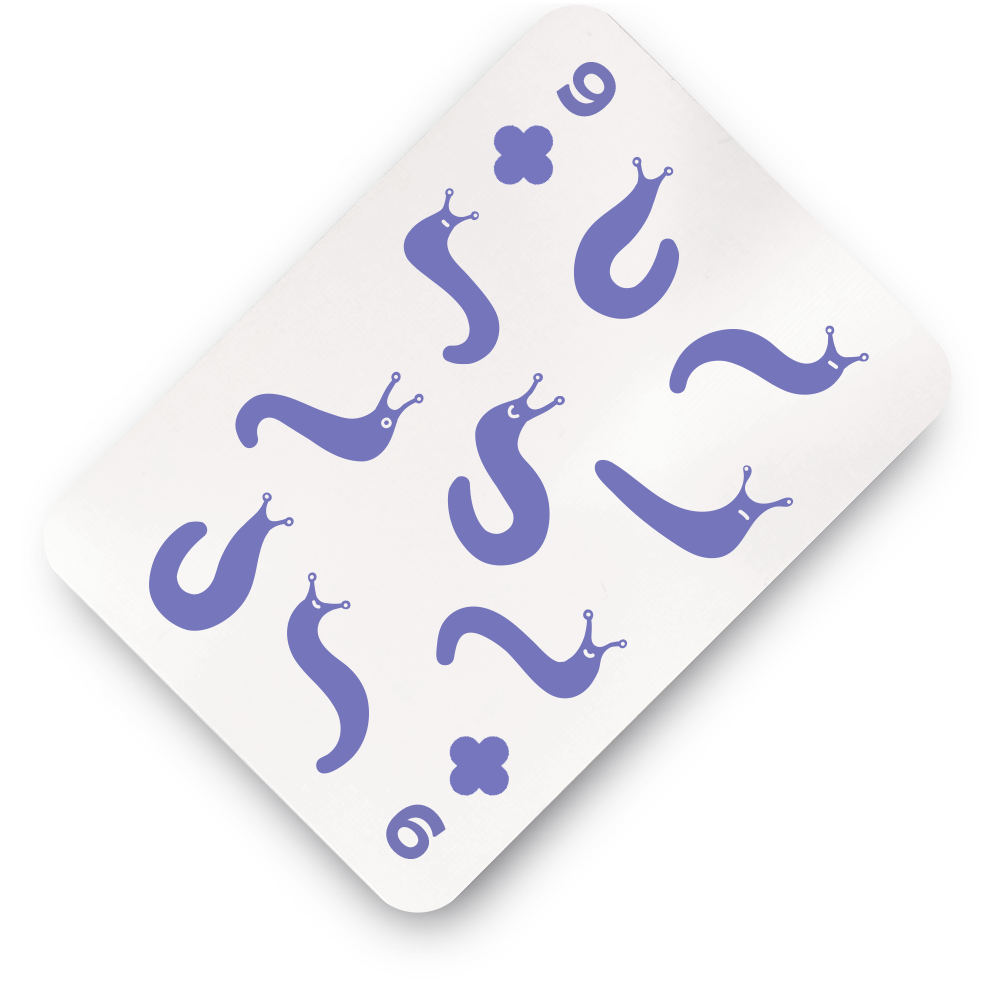
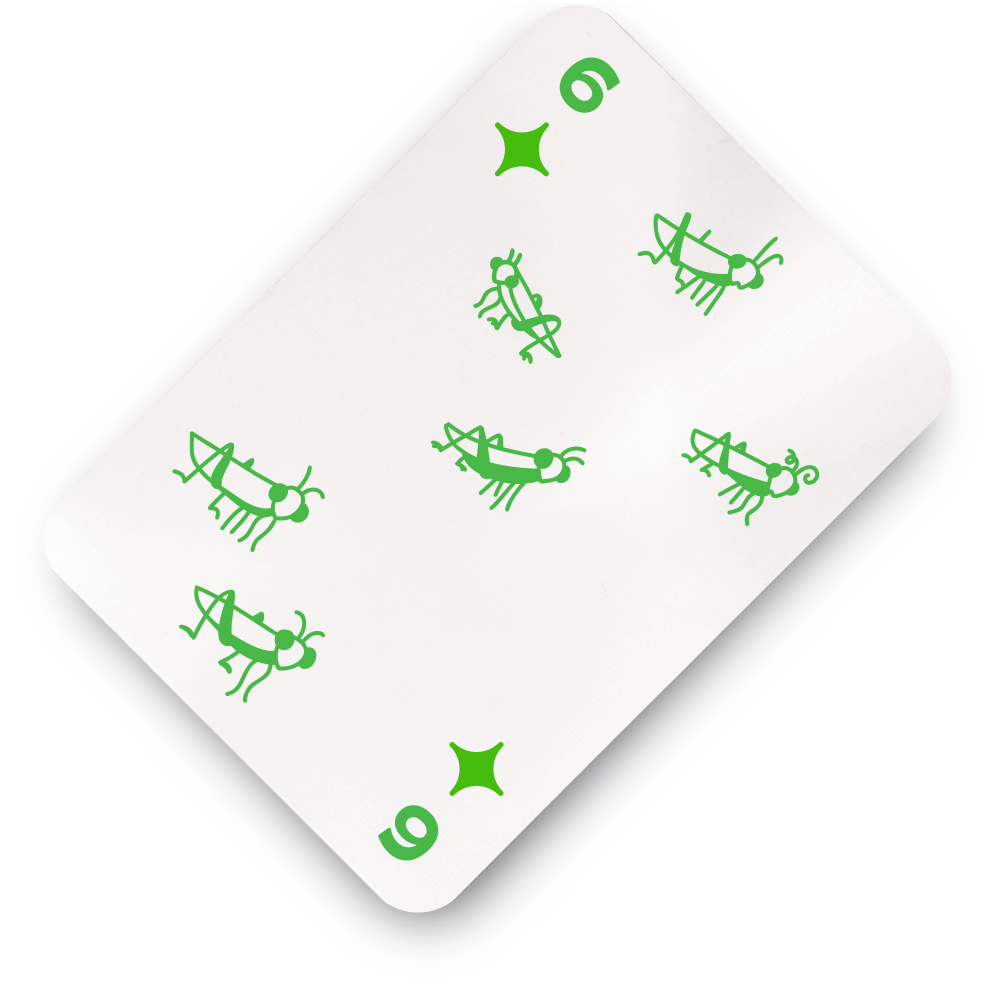

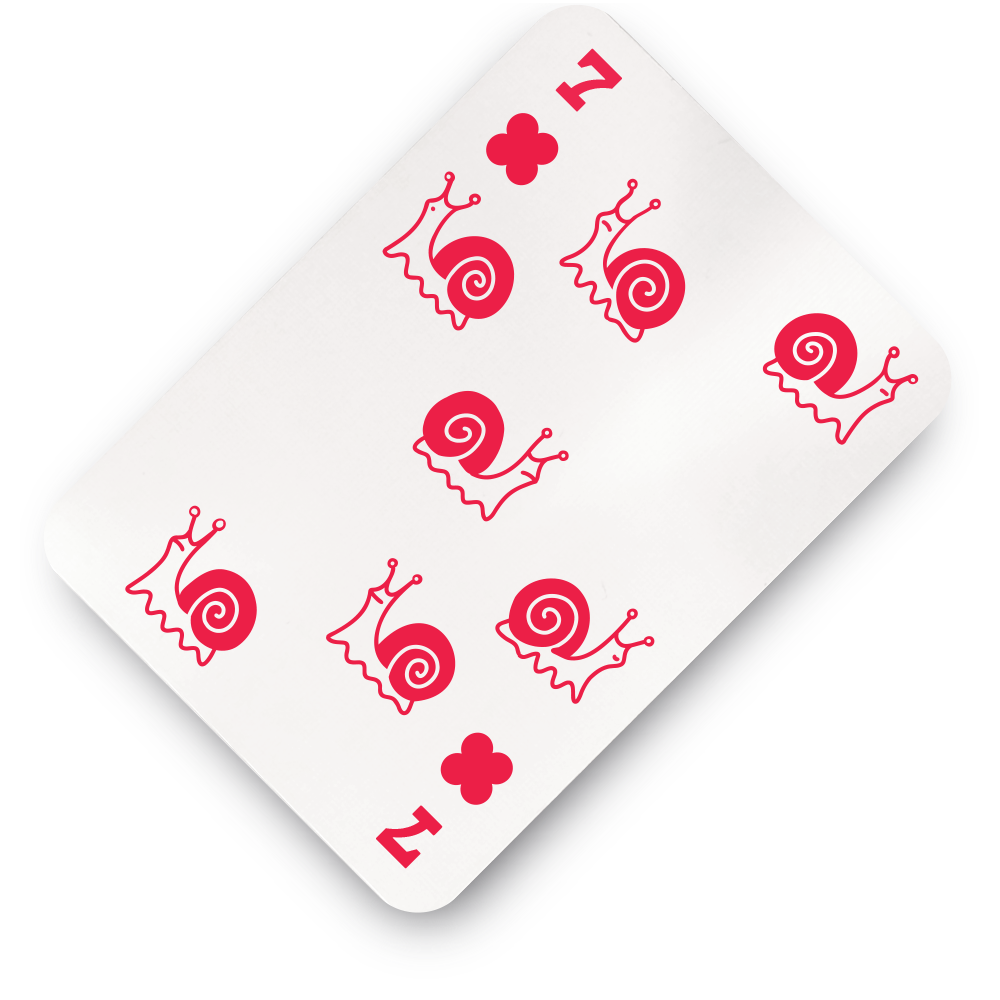
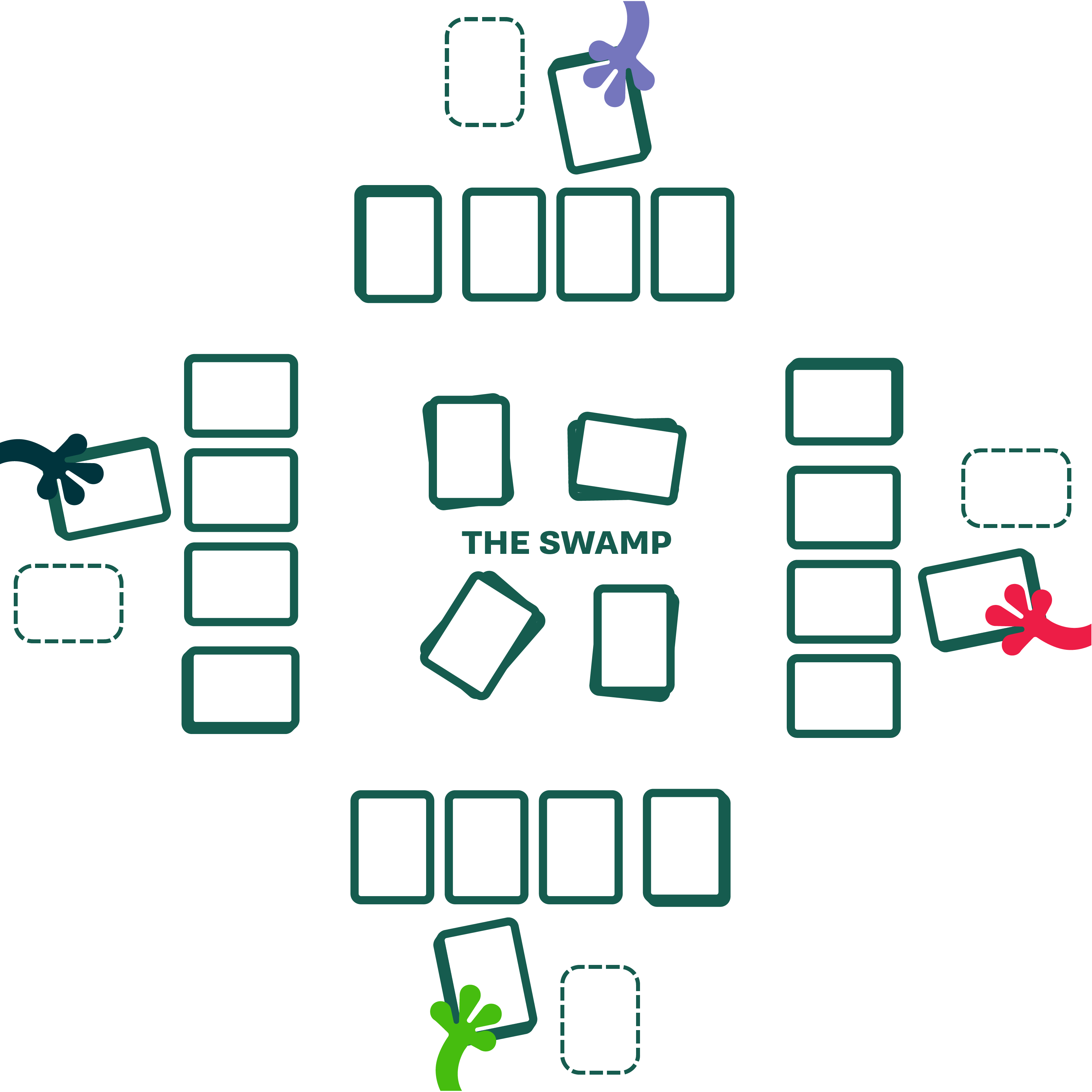
Quick Overview
Accumulate points by playing cards into the SWAMP.
Start a SWAMP pile anytime with a "0" card, or build onto existing piles with cards of alike color in ascending order (1 builds on 0, 2 builds on 1, etc.)Swipe points from your opponents by playing your POND cards the fastest.
If you are the first to drain your POND pile, yell "CROAK" to end the round, cutting off opponents from further scoring. Players will earn 1 point for every cards they played in the SWAMP, and loose 2 points for every card left in their POND.Utilize your LILLYPAD piles for strategic play.
Building onto your LILYPAD piles can help you score more points or drain your POND quicker. LILLYPAD piles can only build in descending order, alternating between INSECTS and GASTROPODS.
Set-Up
Each player shuffles their own deck thoroughly, then draws the top 3 cards (or 5, if playing with 2 players) face up, side-by-side in front of them. these will be the LILYPAD piles. Then, each player counts the next 10 cards and places them in a single pile face up. This is the POND pile. This pile should sit to the right or left of the LILYPAD pile, as to not be confused with your DISCARD pile once the round begins. The players hold their remaining cards stacked face down in their hands, and this will be their STOCKPILE.*
*Players will never view the cards in their hand like in traditional cardgames, but the STOCKPILE will come in handy later.

Play
One player signals the start. everyone begins and plays at the same time, until the end of the round. If any of the exposed cards in front of a player is a number 0 card, it must be placed face up in the SWAMP to begin the first SWAMP pile.

Each number 0 card starts a new SWAMP pile and can always be played immediately. If the card played is from the LILYPAD piles, the empty space is replaced with the top card of their POND pile. Players should always have the same number of LILYPAD piles.
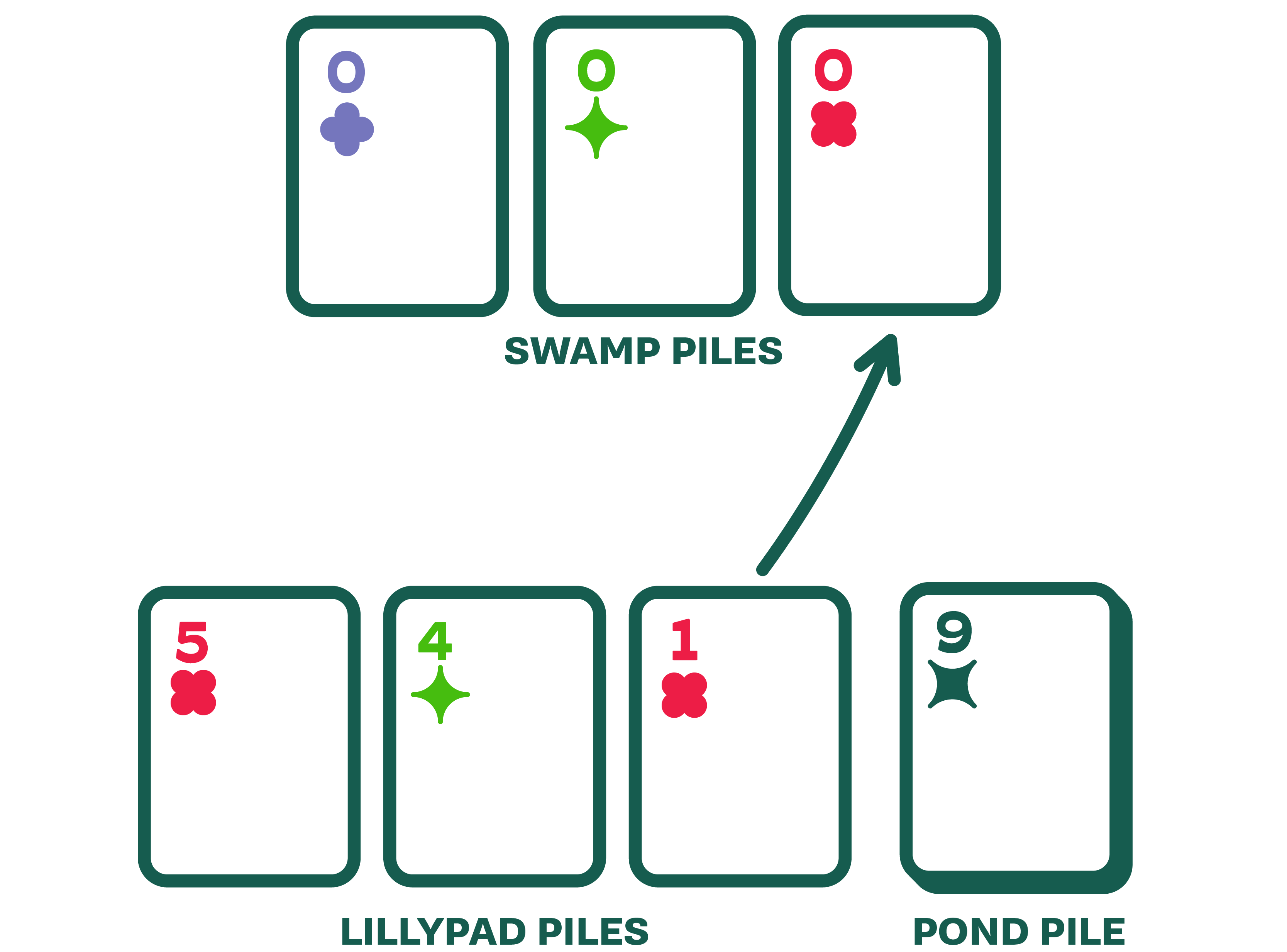
If any player has a number 1 card that matches the suit of any number 0 card that was played into the SWAMP, they can build on that pile by placing it on top of the appropriate suit. Then the same becomes true of number 2 cards which match the suit of any number 1 cards that have been played in the SWAMP. Then 3, and so on, in ascending sequence. Since only one of each number can be played on each pile, players will race to take these moves; see “rules” for refereeing.

If none of a player’s exposed cards can be played at any time, the player will count of the top three cards in their STOCKPILE, turning them over together into a new pile so with the third card on top, face up, in front of them. This forms the last exposed pile in front of the player which can be played onto the SWAMP piles, when possible. Only the top card can played at a time, but when it is played, the card below it becomes exposed and available.
If still no further play can be made, the player repeats the action by couting off three more cards from their hand and placing them on top of new pile, repeating until they can play a card into the SWAMP. If a player exhausts their STOCKPILE, they can reset the STOCKPILE by picking it back up from the table and turing it over without shuffling and proceed.
Playing from your STOCKPILE does not drain your SWAMP, but it is important for accumulating more points.
If still no further play can be made, the player repeats the action by couting off three more cards from their hand and placing them on top of new pile, repeating until they can play a card into the SWAMP. If a player exhausts their STOCKPILE, they can reset the STOCKPILE by picking it back up from the table and turing it over without shuffling and proceed.
Playing from your STOCKPILE does not drain your SWAMP, but it is important for accumulating more points.

If a player desires, they can build on their LILYPAD piles from any of their exposed cards, when possible. LILYPAD piles must be in DESCENDING order, AND they must alternate between INSECTS and GASTROPODS.
You can build onto your LILYPAD piles in any of the following ways, as long as they are in DECEDING order, alternating between INSECTS and GASTROPODS:
A - Building from POND pile
B - Building from one LILYPAD to another, to free up a LILYPAD spot
C - Refilling the LILYPAD spot with a card from the POND pile.
D - Building from DISCARD pile
You can build onto your LILYPAD piles in any of the following ways, as long as they are in DECEDING order, alternating between INSECTS and GASTROPODS:
A - Building from POND pile
B - Building from one LILYPAD to another, to free up a LILYPAD spot
C - Refilling the LILYPAD spot with a card from the POND pile.
D - Building from DISCARD pile
Cards left on your LILYPAD piles at the end of the game do not harm or benefit the player, so they should not hesitate to build on their LILYPAD piles if it helps them eliminate their POND pile. However, building too much on your LILYPAD with your DISCARD pile is not always helpful, and may distract players from the objective.
When a player uses the last card in this POND pile, they should say “CROAK” to signal the end of round.
When a player uses the last card in this POND pile, they should say “CROAK” to signal the end of round.

Scoring
No player should disturb their POND pile until all the cards in the SWAMP are returned to their respective player. All players should help flipping over the SWAMP decks and sorting them back to the players for KERMIT, PRINCESS, HYPNO, and JEREMY.
Once a player collects all their cards which were played in the SWAMP during the round, they should calculate their score by awarding one point for every card returned from the SWAMP, and deducting 2 points for every card remaining in their POND pile. A scorekeeper will collect these figures and add them to the players’ accumulating scores.
After the scorekeeper has recorded the scores, players shuffle their decks for another round. The first player to accumulate 75 points wins the game. If more then one player reaches or surpasses 75 points during the same hand, these players face off in a round to determine the winner.
Rules
Player cannot move more than one card at a time during a round, unless they are moving cards from their hand to the discard. When playing cards into the SWAMP, player may not use both hands. Tossing or throwing cards instead of placing is forbidden
SWAMP PILES: new SWAMP plies can only be started with a number 0 card. cards built on top must increase by one without repeats, and must match suits.
POND PILES: Only the top card of the POND pile should be visible and available for play. The pile should not be shuffled during the round.
LILYPAD piles: These piles can only be built upon in DESCENDING order, alternating between INSECT and GASTROPOD cards. When building on piles, the top card should be added in a manor that exposes the color and number of the card it builds upon (like solitaire). Only top card on each pile can be used for play.
DISCARD pile: Only the top card of the DISCARD should be exposed and available for play. DISCARD piles should never be shuffled during the round.
HAND: Cards must only be turned over in groups of three, unless only one or two cards remain in their hand. In this case, they can turn over what they have left, reset their discard into their hands, and proceed to turn over cards in groups of three again. Cards should only be picked off the top. This deck should never be shuffled during a round.
IF there is a stalemate between all players, and nobody can make a move, everyone should agree to move the top card in their HAND to the bottom of their HAND, providing each player with new cards to play from.

︎︎︎BACK


